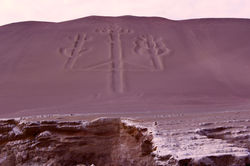Travel advice
Travel advice
Travel advice
Money
Money
Money
Personal safety & security
Personal safety & security
Personal safety & security
.png)

The Desert
Explore sand-dunes, offshore islands & fly over the Nazca lines
BASE CAMP Peru-Travel-Co
Introduction
A 4-hour drive from Lima takes you through the arid pacific desert of Peru. The dry scenery is only interupted by fertile river valleys fed by rivers flowing down from the Andes, here you will see paddy fields of rice, asparragos and orchards of avocado and mango. Using accommodation in the beach of Paracas as a base, you can explore nearby desert landcapes, offshore islands and remains of ancient civilizations.
Things to do
Traveling down the southern coast gives you chance to explore the natural wonders of the desert and explore the ancient remains from past civilizations. You could fly over the enigmatic Nazca lines, these mysterious figures drawn in the desert floor are only properly visible from the air. You can also visit the offshore islands of the Ballestas, which are home to large seal and bird colonies. On the Paracas peninsula you can explore the desert visiting ancients ruins of Tambo Colorado or experience an exciting SUV over the dunes.
History
The peninsula of Paracas is located 250 km south of Lima, just south of the fishing port of Pisco. In the rocky bays of the peninsula are found the ruins of the Paracas Necropolis culture, which was a small but influential civilisation living from 1300BC to 200AD on the Paracas coast. In museums in Lima and Ica, you can find large decorated textiles made by the Paracas people to wrap their dead in the tomb. The dry climate has helped to protect the fine details and vivid colours of the textile, which are considered by many archaeologists as some of the finest weavings in Peru’s history. Inside the buriel chambers, wrapped in the textiles, were found many intact mummies. Some were found to have had undergone primitive brain operations, probably after having suffered a head injury in battle. A hole was cut in the scalp and broken skull fragments removed, then the resulting orifice was covered with a metal plate and the skin repaired. It has been shown that the practice was often successful as the surrounding bone tissue shows signs of healing. Also, many of the bodies were found to have severely deformed skulls, caused by a practice of binding the heads of infants, to produce an elongated skull, probably for aesthetic reasons. In the Julio Tello Museum, a 10 minute drive from the village of Paracas, you can see exhibits explaining the life of the Paracas people and artefacts found in the tombs. Much later in 1820, Paracas was the landing point of Jose de San Martin and his Argentian troops, who had sailed up from Chile escorted by Lord Cochrane. General San Martin then marched on Lima while Lord Cochrane launched an attached from the sea. By 1821, the Spanish fled Lima leaving San Martin to proclaim victory and independence from Colonial Spanish rule. The islands lying of the Peruvian coast are breeding grounds for millions of seabirds, whose droppings had accumulated over centuries, when the Peruvians realised its worth as fertiliser in the 1840’s. The fledgling republic was starting to trade with other countries, especially France and England, and for the following years, Guano fertilizer was the countries main export, providing Peru with 80% of its income. With the income of the Guano, the President Ramon Castillo bought the freedom of the black slaves from their owners. After years of exploitation, many of the islands dropped 100 ft in height as the droppings were slowly extracted. But by the 1870`s the reserves were exhausted and the country had to look to other forms of income, sparking the rubber boom in the Amazon jungle.
Climate
There is obviously little or no rainfall in Paracas, being located in the arid coastal desert of Peru. The hottest months are from December through until April, when daytime temperatures reach 26°C and drop to 18°C at night. Throughout the rest of the year, the skies can sometimes be overcast with temperatures ranging from 20°C to 12°C.
 |  |  |
|---|---|---|
 |  |  |
 |  |  |
 |  |  |
 |  |  |